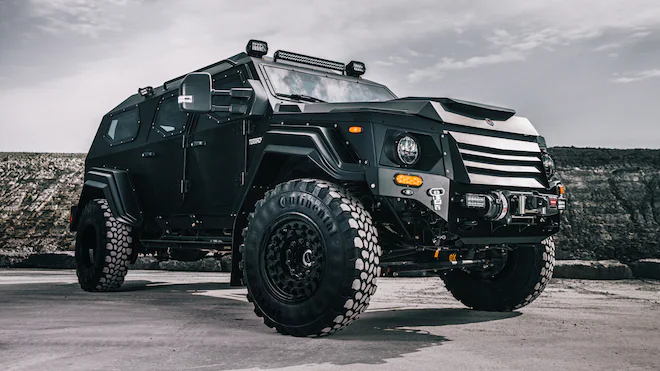Peacekeeping operations in conflict zones require a unique blend of courage, skill, and specialized equipment to ensure the safety of personnel and facilitate the restoration of peace. Armoured cars have emerged as a crucial asset in these operations, providing enhanced protection and mobility in hostile environments. In this article, we will explore the role of armoured cars in peacekeeping efforts and how they contribute to enhancing safety and security in conflict zones.
- Protection Against Ballistic Threats: Armoured cars are designed to withstand ballistic threats, including small arms fire and explosive devices. With reinforced body panels and specialized materials, these vehicles provide a high level of protection for peacekeepers operating in dangerous areas. This increased ballistic resistance allows personnel to move through conflict zones with reduced risk of injury or fatality.
- Mobility in Challenging Terrain: Conflict zones often feature challenging terrains, including rough roads, uneven landscapes, and obstacles. Armoured cars are equipped with robust suspension systems and powerful engines that enable them to traverse these terrains with relative ease. The vehicles’ off-road capabilities enhance the mobility of peacekeepers, ensuring they can reach remote areas and respond effectively to incidents or threats.
- Rapid Response and Tactical Support: Armoured cars offer peacekeeping forces the ability to respond swiftly to emerging situations and provide tactical support when needed. Equipped with advanced communication systems and reinforced structures, these vehicles act as mobile command centers, allowing peacekeepers to coordinate operations and make informed decisions on the ground. The presence of armoured cars can deter potential threats and bolster the confidence of personnel in high-risk situations.
- Versatility and Adaptability: Armoured cars are designed to be versatile and adaptable to a variety of peacekeeping scenarios. They can be customized with additional equipment, such as surveillance systems, communication antennas, and non-lethal weapons, to meet the specific requirements of a mission. This flexibility ensures that peacekeepers have the necessary tools and resources to address evolving challenges in conflict zones.
- Medical Support and Evacuation: Armoured cars can be equipped with medical facilities to provide immediate medical support to injured personnel in the field. These vehicles may have compartments for medical supplies, stretchers, and even limited surgical capabilities. In critical situations, armoured cars can also serve as evacuation vehicles, transporting injured peacekeepers to safer locations or medical facilities.
- Interaction with Local Communities: Armoured cars play a vital role in fostering positive interactions between peacekeepers and local communities. The vehicles serve as a visible presence, promoting a sense of security and trust among the local population. By establishing a visible and approachable presence, armoured cars contribute to building relationships, gathering vital intelligence, and facilitating the delivery of humanitarian aid in conflict-affected areas.
- Improving Situational Awareness: Armoured cars are equipped with advanced surveillance and monitoring systems that enhance situational awareness for peacekeepers. These systems may include cameras, sensors, and even drones that provide real-time intelligence on the ground. This improved situational awareness enables peacekeepers to anticipate threats, detect potential ambushes, and respond proactively, enhancing overall safety and security.
- Collaborative Efforts: Armoured car manufacturers often collaborate with peacekeeping organizations and military forces to develop vehicles tailored to the specific needs of peacekeeping operations. These collaborations ensure that armoured cars are designed with input from those who understand the unique challenges faced by peacekeepers in conflict zones. The resulting vehicles are optimized for the operational environment and can better meet the requirements of peacekeeping missions.
- Training and Skill Development: Effective use of armoured cars in peacekeeping operations requires specialized training for personnel. Peacekeeping forces invest in training programs to ensure that peacekeepers understand the capabilities and limitations of these vehicles. Training covers vehicle operations, maintenance, defensive driving techniques, and the use of integrated communication and surveillance systems. By equipping peacekeepers with the necessary skills, armoured cars become valuable tools for ensuring their safety and security in conflict zones.
- Long-Term Impact: The presence of armoured cars in peacekeeping missions has a long-term impact beyond immediate security. By helping establish stability and security in conflict zones, these vehicles create an environment conducive to rebuilding infrastructure, supporting humanitarian aid efforts, and facilitating the reestablishment of essential services. Armoured cars, therefore, contribute to laying the foundations for lasting peace and development in post-conflict regions.
In conclusion, armoured cars play a vital role in peacekeeping efforts by enhancing safety and security in conflict zones. With their ballistic protection, mobility, rapid response capabilities, and adaptability, these vehicles provide peacekeepers with the necessary tools to operate effectively in hostile environments. By fostering trust, improving situational awareness, and enabling rapid medical support, armoured cars contribute to the overall success of peacekeeping missions and the restoration of peace in conflict-affected areas.
